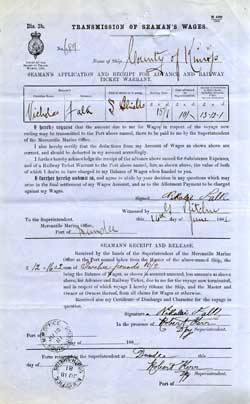What was Sailortown?
What was sailortown? Answering this question without generalising is difficult. Instead, it is more useful to ask what contemporary writers thought sailortown was–and then compare it to the wide variety of sailortowns around the world. To nineteenth century writers, sailortown was a location that had several important characteristics:
- there was a large concentration of pubs, boarding-houses and brothels;
- it was an area of frequent crime and considerable poverty;
- it was an area expressly connected with international seafaring labour.
The two first points existed anywhere in the ports where sailors frequented, yet sailortowns were specifically the spaces that seafarers favoured. Beyond the proximity of sailortown to the waterfront, it is difficult to say why seafarers chose certain places to congregate–such as Radcliffe Highway in London. It was likely a combination of geography and economic factors which decided where sailortowns were. In addition, seafarers needed to be present to create a sailortown but the desired amenities also had to be there in order to attract the seafarers. Once a sailortown was established as such, it became a draw for seafarers, not only because it provided services they desired, but also because most seafarers were not locals of the port and they relied on their fellows to negotiate the docklands. Even shipmasters would sometimes point out the cheapest type of liquor or the best tavern,
When I'd give them the money I always used to add on like this: I'd say, "Now look here, there's lots of wine here damned cheap." Or if it was in the West Indies, I'd say, "There's plenty of rum here and it's only a cent a glass, ten cents a bottle" (Barnes 1931, 17).
Sailortowns were not only physical places, they were also signposts for a labour group comprised almost exclusively of seafarers who came from other parts of the world.
Of course there were seafarers who never went to a sailortown, despite the almost magnetic attraction these places seemed to have had. In reality, there was nothing besides peer pressure forcing the seafarer to go to there. Many men took advantage of the option to buy a train ticket with their wages and went home. And even if they stayed in their discharge port, the possibility of visiting a part of the city not considered sailortown was always there. Though sailors had once been visually distinct–wearing clothing very specific to their occupation (Styles 200) –by the late-nineteenth century this was no longer the case, and it would have been increasingly difficult for observers to pick a seafarer out of a crowd. This works both ways, so it is also important to remember that not all the people which sailortown served were seafarers.
A Political Economist's Word on Ports
Ports around the world from M'Culloch's Commercial Dictionary, 1871 edition. M'Culloch's was one of several books written to instruct British merchants and shipmasters about laws, navigation, geography and other matters.
New York bay, or inner harbour, is one of the finest and most capacious in the world; it is completely landlocked, and affords the best anchorage. The entrance to the bay through the narrows is extremely beautiful. On each side, the shore, though wooded down to the water's edge, is thickly studded with farms, villages, and country seats. Originally the houses were mostly of wood and the streets narrow and confined In these particulars, however, a vast improvement has taken place during this century, most of the old houses having been pulled down and rebuilt with brick. The new streets, which are board, and intersect each other at right angles, are well paved and lighted.
Halifax is situated on a peninsula on the west side of Chebucto Bay and has one of the finest harbours in America. The town is irregularly built, and most of the houses are of wood. The Government-house is one of the most splendid edifices in North America. The harbour is defended by several strong forts. Ships usually anchor abreast of town, where the harbour is rather more than 1 mile in width.
Singapore is one of several British dependencies, called the Straits Settlements. These possessions came to under British rule at different periods, but were in 1826 united into one government. Singapore is an island at the south-eastern extremity of the straits of Malacca. The British settlement embraces a circumference of 128 miles, in which are included about 75 islets. Singapore has been from its foundation a free port, in the widest sense of the term, open to the flags of every nation, and without either import or export duties on goods. It has thus become an entrepôt in which are brought together and exchanged the products and manufactures of the western world, of Indian, Cochin China, Siam, the Malayan Peninsula and of the whole wide region of the Eastern Archipelago from its western limits in Sumatra, to the meridian of New Guinea and the Philippines.
The harbour of Rio de Janeiro is one of the finest in the world, both as respects capaciousness and security for all sorts of vessels. The trade of Rio is extensive and has increased rapidly of late years. It is now by far the greatest mart of the export of coffee. The export of gold, diamonds, etc, though very considerable, is mostly clandestine.
Owning to a want of attention at first, the streets of Sydney were laid out, and the houses built, according to the views of individuals, without any fixed or regular plan. But latterly this defect has been to a considerable degree remedied in the old streets; and the new ones are systematically laid out. Port Jackson is one of the finest natural basins in the world. It stretches about 15 miles into the country, and has numerous creeks and bays; the anchorage everywhere is excellent.
Calcutta is the principal city of the Presidency of Bengal, the capital of British dominions in India. It is about 100 miles from the sea, being situated on the eastern bank of the western branch of the Ganges, dominating the Hooghly River, which is the only arm of the Ganges navigable to any considerable distance by large ships.
Some Definitions
Crimp: A person who manages a seafarer's wages while on shore. This can include securing accommodations, arranging for a tab at pub, supplying prostitutes and finding a berth aboard an outbound ship. Crimps were often runners, or scouts, for masters of boarding houses.
Crimping: Managing the wages and labour of seafarers. The crimp would encourage seafarers to desert, thereby making it necessary for the crewless ship to sign-on a new crew. The crimps then provided a replacement crew for better wages, taking a cut in the form the advance. Sometimes this encouraged shanghaiing.
Shanghaiing: An extreme form of crimping where sailors would be rendered senseless – either by drink, drugs or blunt instrument – and then were signed-on to a ship. The crimp would get the advance note and the seafarer would wake up in the fo's'cle [forecastle] the next day at sea.
Advance Note: A note authorising the advanced payment of wages.
Shipping Office: The official place where the ship's crew agreements were signed. The officers of the shipping office and crimps were often at odds.


